Related Research Articles

The Continuation War, also known as the Second Soviet-Finnish War, was a conflict fought by Finland and Nazi Germany against the Soviet Union during World War II. It began with a Finnish declaration of war and invasion on 25 June 1941 and ended on 19 September 1944 with the Moscow Armistice. The Soviet Union and Finland had previously fought the Winter War from 1939 to 1940, which ended with the Soviet failure to conquer Finland and the Moscow Peace Treaty. Numerous reasons have been proposed for the Finnish decision to invade, with regaining territory lost during the Winter War regarded as the most common. Other justifications for the conflict include Finnish President Risto Ryti's vision of a Greater Finland and Commander-in-Chief Carl Gustaf Emil Mannerheim's desire to annex East Karelia.
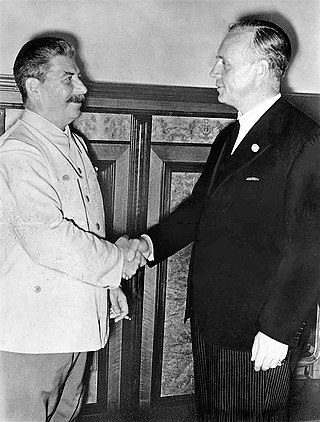
The Molotov–Ribbentrop Pact, officially the Treaty of Non-Aggression between Germany and the Union of Soviet Socialist Republics, was a non-aggression pact between Nazi Germany and the Soviet Union with a secret protocol that partitioned Central and Eastern Europe between them. The pact was signed in Moscow on 23 August 1939 by German Foreign Minister Joachim von Ribbentrop and Soviet Foreign Minister Vyacheslav Molotov. Unofficially, it has also been referred to as the Hitler–Stalin Pact and the Nazi–Soviet Pact.
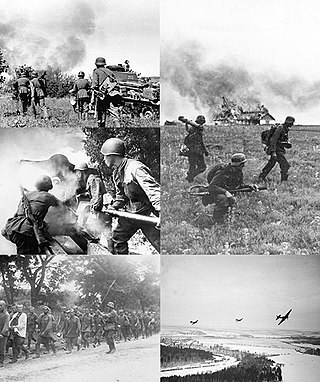
Operation Barbarossa was the invasion of the Soviet Union by Nazi Germany and many of its Axis allies, starting on Sunday, 22 June 1941, during the Second World War. It was the largest land offensive in human history, with around 10 million combatants taking part. The operation, code-named after Frederick Barbarossa, a 12th-century Holy Roman Emperor and Crusader, put into action Nazi Germany's ideological goals of eradicating communism, and conquering the western Soviet Union to repopulate it with Germans. The German Generalplan Ost aimed to use some of the conquered people as forced labour for the Axis war effort while acquiring the oil reserves of the Caucasus as well as the agricultural resources of various Soviet territories, including Ukraine and Byelorussia. Their ultimate goal was to create more Lebensraum for Germany, and the eventual extermination of the native Slavic peoples by mass deportation to Siberia, Germanisation, enslavement, and genocide.
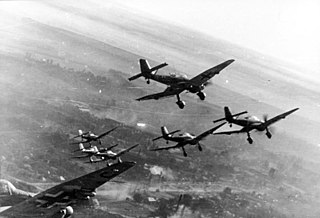
World War II or the Second World War was a global conflict that lasted from 1939 to 1945. The vast majority of the world's countries, including all the great powers, fought as part of two opposing military alliances: the Allies and the Axis. Many participating countries invested all available economic, industrial, and scientific capabilities into this total war, blurring the distinction between civilian and military resources. Aircraft played a major role, enabling the strategic bombing of population centres and delivery of the only two nuclear weapons ever used in war. It was by far the deadliest conflict in history, resulting in 70–85 million fatalities. Millions died due to genocides, including the Holocaust, as well as starvation, massacres, and disease. In the wake of Axis defeat, Germany, Austria, and Japan were occupied, and war crime tribunals were conducted against German and Japanese leaders.

The Winter War was a war between the Soviet Union and Finland. It began with a Soviet invasion of Finland on 30 November 1939, three months after the outbreak of World War II, and ended three and a half months later with the Moscow Peace Treaty on 13 March 1940. Despite superior military strength, especially in tanks and aircraft, the Soviet Union suffered severe losses and initially made little headway. The League of Nations deemed the attack illegal and expelled the Soviet Union.

The Axis powers, originally called the Rome–Berlin Axis and also Rome–Berlin–Tokyo Axis, was a military coalition that initiated World War II and fought against the Allies. Its principal members were Nazi Germany, the Kingdom of Italy and the Empire of Japan. The Axis were united in their far-right positions and general opposition to the Allies, but otherwise lacked comparable coordination and ideological cohesion.

The Tripartite Pact, also known as the Berlin Pact, was an agreement between Germany, Italy, and Japan signed in Berlin on 27 September 1940 by, respectively, Joachim von Ribbentrop, Galeazzo Ciano, and Saburō Kurusu and in the presence of Adolf Hitler. It was a defensive military alliance that was eventually joined by Hungary, Romania, Bulgaria, and Yugoslavia as well as by the German client state of Slovakia. Yugoslavia's accession provoked a coup d'état in Belgrade two days later. Germany, Italy, and Hungary responded by invading Yugoslavia. The resulting Italo-German client state, known as the Independent State of Croatia, joined the pact on 15 June 1941.

The Anti-Comintern Pact, officially the Agreement against the Communist International was an anti-Communist pact concluded between Nazi Germany and the Empire of Japan on 25 November 1936 and was directed against the Communist International (Comintern). It was signed by German ambassador-at-large Joachim von Ribbentrop and Japanese ambassador to Germany Kintomo Mushanokōji. Italy joined in 1937, but it was legally recognised as an original signatory by the terms of its entry. Spain and Hungary joined in 1939. Other countries joined during World War II.
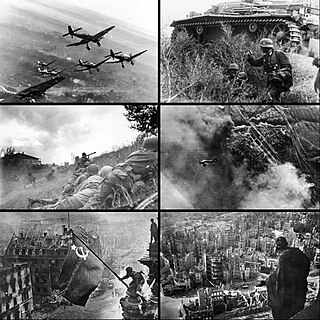
The European theatre of World War II was one of the two main theatres of combat during World War II. It saw heavy fighting across Europe for almost six years, starting with Germany's invasion of Poland on 1 September 1939 and ending with the Western Allies conquering most of Western Europe, the Soviet Union conquering most of Eastern Europe including the German capital Berlin, and Germany's unconditional surrender on 8 May 1945 although fighting continued elsewhere in Europe until 25 May. On 5 June 1945, the Berlin Declaration proclaiming the unconditional surrender of Germany to the four victorious powers was signed. The Allied powers fought the Axis powers on two major fronts, but there were other fronts varying in scale from the Italian campaign, to the Polish Campaign, as well as in a strategic bombing offensive and in the adjoining Mediterranean and Middle East theatre.
A non-belligerent is a person, a state, or other organization that does not fight in a given conflict. The term is often used to describe a country that does not take part militarily in a war.

The causes of World War II have been given considerable attention by historians. The immediate precipitating event was the invasion of Poland by Nazi Germany on September 1, 1939, and the subsequent declarations of war on Germany made by Britain and France, but many other prior events have been suggested as ultimate causes. Primary themes in historical analysis of the war's origins include the political takeover of Germany in 1933 by Adolf Hitler and the Nazi Party; Japanese militarism against China, which led to the Japanese invasion of Manchuria and the Second Sino-Japanese War; Italian aggression against Ethiopia, which led to the Second Italo-Ethiopian War; the consent of Western countries to Germany's actions on the annexation of Austria and the partition of Czechoslovakia; and Germany's initial success in negotiating the Molotov–Ribbentrop Pact with the Soviet Union to divide the territorial control of Eastern Europe between them.

Finland participated in the Second World War initially in a defensive war against the Soviet Union, followed by another, this time offensive, war against the Soviet Union acting in concert with Nazi Germany and then finally fighting alongside the Allies against Germany.
The Franco-Polish Alliance was the military alliance between Poland and France that was active between the early 1920s and the outbreak of the Second World War. The initial agreements were signed in February 1921 and formally took effect in 1923. During the interwar period the alliance with Poland was one of the cornerstones of French foreign policy.

The Allies, formally referred to as the United Nations from 1942, were an international military coalition formed during World War II (1939–1945) to oppose the Axis powers. Its principal members by the end of 1941 were the "Big Four" – United Kingdom, United States, Soviet Union, and China.

The Soviet invasion of Poland was a military conflict by the Soviet Union without a formal declaration of war. On 17 September 1939, the Soviet Union invaded Poland from the east, 16 days after Nazi Germany invaded Poland from the west. Subsequent military operations lasted for the following 20 days and ended on 6 October 1939 with the two-way division and annexation of the entire territory of the Second Polish Republic by Nazi Germany and the Soviet Union. This division is sometimes called the Fourth Partition of Poland. The Soviet invasion of Poland was indirectly indicated in the "secret protocol" of the Molotov–Ribbentrop Pact signed on 23 August 1939, which divided Poland into "spheres of influence" of the two powers. German and Soviet cooperation in the invasion of Poland has been described as co-belligerence.

The neutral powers were countries that remained neutral during World War II. Some of these countries had large colonies abroad or had great economic power. Spain had just been through its civil war, which ended on 1 April 1939 —a war that involved several countries that subsequently participated in World War II.

During World War II, the Soviet Union occupied and annexed several countries effectively handed over by Nazi Germany in the secret Molotov–Ribbentrop Pact of 1939. These included the eastern regions of Poland, as well as Latvia, Estonia, Lithuania, part of eastern Finland and eastern Romania. Apart from the Molotov–Ribbentrop Pact and post-war division of Germany, the USSR also occupied and annexed Carpathian Ruthenia from Czechoslovakia in 1945.
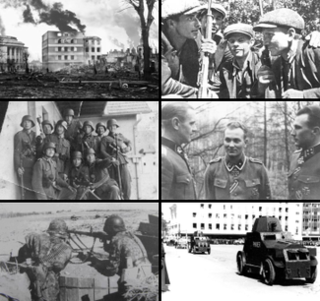
Estonia declared neutrality at the outbreak of World War II (1939–1945), but the country was repeatedly contested, invaded and occupied, first by the Soviet Union in 1940, then by Nazi Germany in 1941, and ultimately reinvaded and reoccupied in 1944 by the Soviet Union.
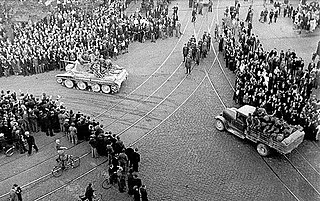
The Soviet occupation of Latvia in 1940 refers to the military occupation of the Republic of Latvia by the Soviet Union under the provisions of the 1939 Molotov–Ribbentrop Pact with Nazi Germany and its Secret Additional Protocol signed in August 1939. The occupation took place according to the European Court of Human Rights, the Government of Latvia, the United States Department of State, and the European Union. In 1989, the USSR also condemned the 1939 secret protocol between Nazi Germany and herself that had led to the invasion and occupation of the three Baltic countries, including Latvia.
The diplomatic history of World War II includes the major foreign policies and interactions inside the opposing coalitions, the Allies of World War II and the Axis powers, between 1939 and 1945.
References
- ↑ John P Grant; J.Craig Barker (2 October 2009). Parry and Grant Encyclopaedic Dictionary of International Law. Oxford University Press. p. 102. ISBN 978-0-19-987491-0.
- ↑ "Article 4 - Definition of protected persons". International Committee of the Red Cross.
- ↑ Gary D. Solis (April 18, 2016). The Law of Armed Conflict: International Humanitarian Law in War. Cambridge University Press. pp. 252–253. ISBN 9-7811-0713-5604.
- ↑ "Commentary of 1958: Article 4 - Definition of protected persons". International Committee of the Red Cross.
- ↑ The Prosecutor v. Duško Tadić, 164 and 165( International Criminal Tribunal for the former Yugoslavia July 15, 1999)("In the cases provided for in Article 4(2)[of the Fourth Geneva Convention], in addition to nationality, account was taken of the existence or non-existence of diplomatic protection: nationals of a neutral State or a co-belligerent State are not treated as “protected persons” unless they are deprived of or do not enjoy diplomatic protection. In other words, those nationals are not “protected persons” as long as they benefit from the normal diplomatic protection of their State; when they lose it or in any event do not enjoy it, the Convention automatically grants them the status of “protected persons”."), Text .
- ↑ Hager, Robert P. (2017-03-01). ""The laughing third man in a fight": Stalin's use of the wedge strategy". Communist and Post-Communist Studies. 50 (1): 15–27. doi:10.1016/j.postcomstud.2016.11.002. ISSN 0967-067X.
The Soviet Union participated as a cobelligerent with Germany after September 17, 1939, when Soviet forces invaded eastern Poland
- ↑ Blobaum, Robert (1990). "The Destruction of East-Central Europe, 1939-41". Problems of Communism. 39: 106.
As a co-belligerent of Nazi Germany, the Soviet Union secretly assisted the German invasion of central and western Poland before launching its own invasion of eastern Poland on September 17
- ↑ Mauno Jokipii, Hitlerin Saksa ja sen vapaaehtoisliikkeet, Suomalaisen Kirjallisuuden Seura, 2002, ISBN 951-746-335-9
- ↑ Reime, Hannu (8 October 2010). "Un-Finnish Business". Haaretz. Retrieved 30 August 2017.
- ↑ "Treaty of Peace With Finland". 1947. p. 229. Retrieved 23 October 2020.
- ↑ Mäkinen, Esa (19 October 2008). "Historian professorit hautaavat pitkät kiistat". Helsingin Sanomat. Retrieved 7 February 2021.
- ↑ Rebecca Ingber, Co-Belligerency, 42 Yale J. Int'l Law 67 (2017)
- ↑ Ingber, Rebecca, Co-Belligerency (2017). 42 Yale J. Int'l Law 67 (2017), Boston Univ. School of Law, Public Law Research Paper No. 16-37, Available at SSRN: https://ssrn.com/abstract=2837152
- ↑ "RUSSIAN OFFENSIVE CAMPAIGN ASSESSMENT, DECEMBER 11". Institute for the Study of War . 11 December 2022.
- ↑ "RUSSIAN OFFENSIVE CAMPAIGN ASSESSMENT, OCTOBER 11". Institute for the Study of War. 11 October 2022.
- ↑ "Belarus to keep helping Russia but unlikely to send its troops to join Russia's fighting in Ukraine". Euromaidan Press. 12 December 2022.